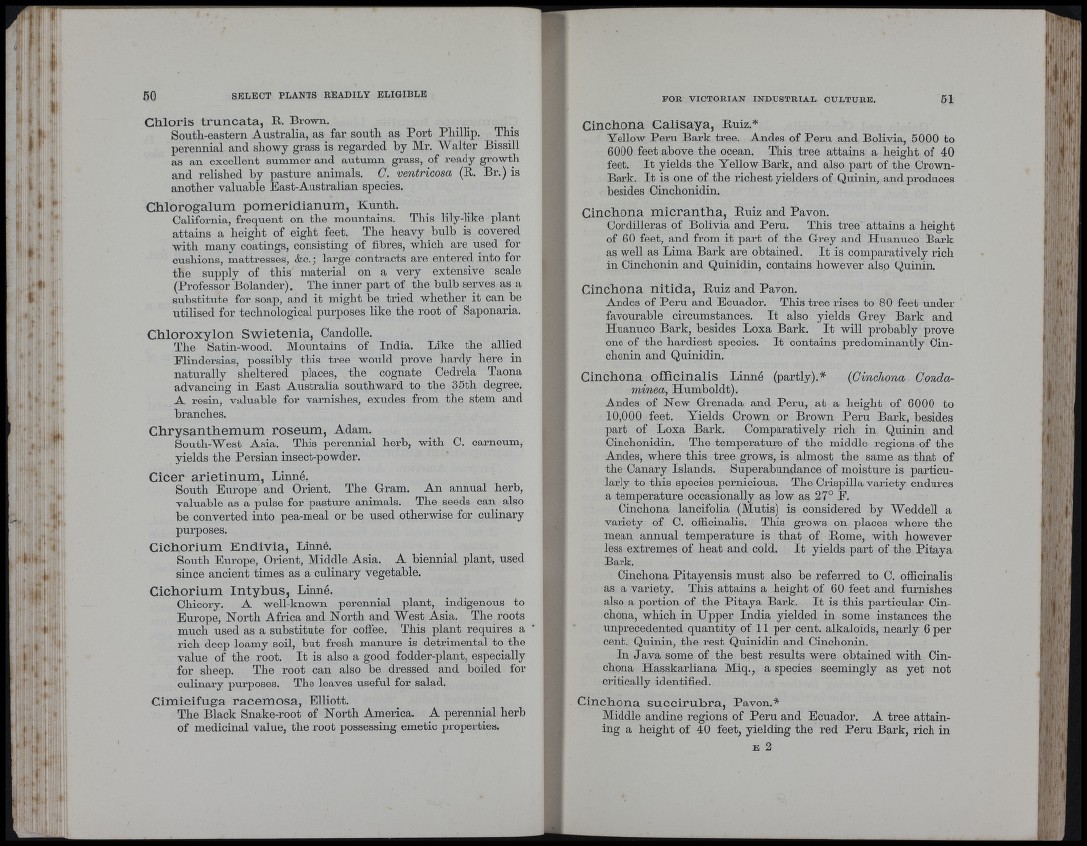
: : í
^ s' ini
í^ ' fill
f
il : k :. I
I •nÁ\i- i
ill
50 SELECT PLANTS READILY ELIGIBLE
Chloris trúncala, K Brown.
South-eastern Australia, as far south as Port Phillip. This
perennial and showy grass is regarded by Mr. Walter Bissill
as an excellent summer and autumn grass, of ready growth
and relished by pasture animals. C. ventricosa (B. Br.) is
another valuable East-Australian species.
Cblorogalum pomeridianum, Kxinth.
California, frequent on the mountains. This lily-like plant
attains a height of eight feet. The heavy bulb is covered
with many coatings, consisting of fibres, which are used for
cushions, mattresses, &c. ; lai-ge contracts are entered into for
the supply of this material on a very extensive scale
(Professor Bolandei'). The inner part of the bulb serves as a
substitute for soap, and it might be tried whether it can be
utilised for technological purposes like the root of Saponaria.
Cbloroxylon Swietenia, Candolle.
The Satin-wood. Mountains of India. Like the allied
Elindersias, possibly this tree would prove hardy here in
naturally sheltered places, the cognate Cedrela Taona
advancing in East Australia southward to tbe 35th degree.
A resin, valuable for varnishes, exudes from the stem and
branches.
Chrysanthemum roseum, Adam.
South-West Asia. This perennial herb, with C. carnenm,
yields the Persian insect-powder.
Cicer arietinum, Linné.
South Europe and Orient. The Gram. An annual herb,
valuable as a pulse for pasture animals. The seeds can also
be converted into pea-meal or be used otherwise for culinary
purposes.
Cichorium Endivia, Linné.
South Europe, Orient, Middle Asia. A biennial plant, used
since ancient times as a culinary vegetable.
Cichorium lutybus, Linné.
Chicory. A well-known perennial plant, indigenous to
Europe, North Africa and North and West Asia. The roots
much used as a substitute for cofiee. This plant requires a ‘
rich deep loamy soil, but fresh manure is detrimental to the
value of the root. I t is also a good fodder-plant, especially
for sheep. The root can also be dressed and boiled for
culinary purposes. The leaves useful for salad.
Cimicifuga racemosa, Elliott.
The Black Snake-root of North America. A perennial herb
of medicinal value, the root possessing emetic properties.
FOR VICTORIAN INDUSTRIAL CULTURE. 51
Ciuchoua Calisaya, Buiz.*
Yellow Peru Bark tree. Andes of Peru and Bolivia, 5000 to
6000 feet above the ocean. This tree attains a height of 40
feet. I t yields the Yellow Bark, and also part of the Crown-
Bark. I t is one of the richest yielders of Quinin, and produces
besides Cinchonidin.
Ciuchoua micrautha, Buiz and Pavon.
Cordilleras of Bolivia and Peru. This tree attains a height
of 60 feet, and from it part of tbe Grey and Huanuco Bark
as well as Lima Bark are obtained. I t is comparatively rich
in Cinchonin and Quinidin, contains however also Quinin.
Ciuchoua uitida, Buiz and Pavon.
Andes of Peru and Ecuador. This tree rises to 80 feet under
favourable circumstances. I t also yields Grey Bark and
Huanuco Bark, besides Loxa Bark. I t will probably prove
one of the hardiest species. I t contains predominantly Cinchonin
and Quinidin.
Ciuchoua officiualis Linné (partly).* (Cinchona Conda-
minea, Humboldt).
Andes of New Grenada and Peru, at a height of 6000 to
10,000 feet. Yields Crown or Brown Peru Bark, besides
part of Loxa Bark. Comparatively rich in Quinin and
Cinchonidin. The temperature of the middle regions of the
Andes, where this tree grows, is almost the same as th a t of
the Canary Islands. Superabundance of moisture is particularly
to this species pernicious. Tbe Crispilla variety endures
a temperature occasionally as low as 27° P.
Cinchona lancifolia (Mutis) is considered by Weddell a
variety of C. oificinalis. This grows on places where the
mean annual temperature is th a t of Borne, with however
less extremes of heat and cold. I t yields part of the Pitaya
Bark.
Cinchona Pitayensis must also be referred to C. officinalis
as a variety. This attains a height of 60 feet and furnishes
also a portion of the Pitaya Bark. I t is this particular Cinchona,
which in Upper India yielded in some instances the
unprecedented quantity of 11 per cent, alkaloids, nearly 6 per
cent. Quinin, the rest Quinidin and Cinchonin.
In Java some of the best results were obtained with Cinchona
Hasskarliana Miq., a species seemingly as yet not
critically identified.
Ciuchoua succirubra, Pavon.*
Middle andine regions of Peru and Ecuador. A tree attaining
a height of 40 feet, yielding the red Peru Bark, rich in
î(.
i'l ■'